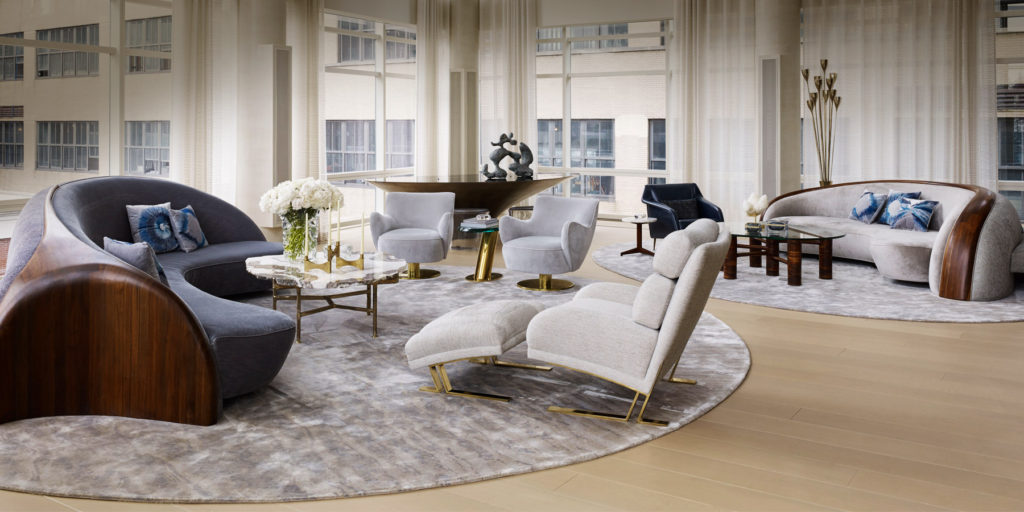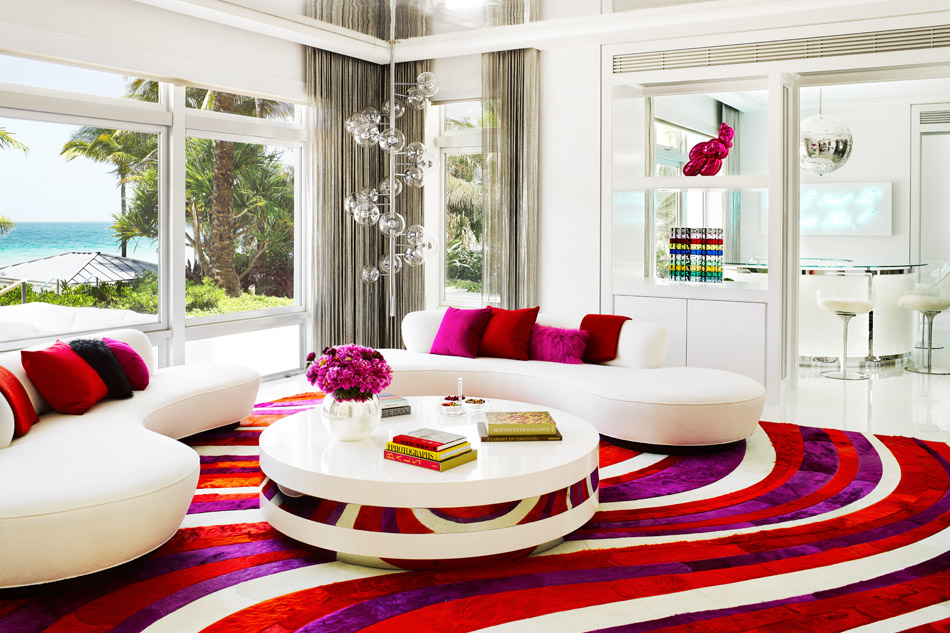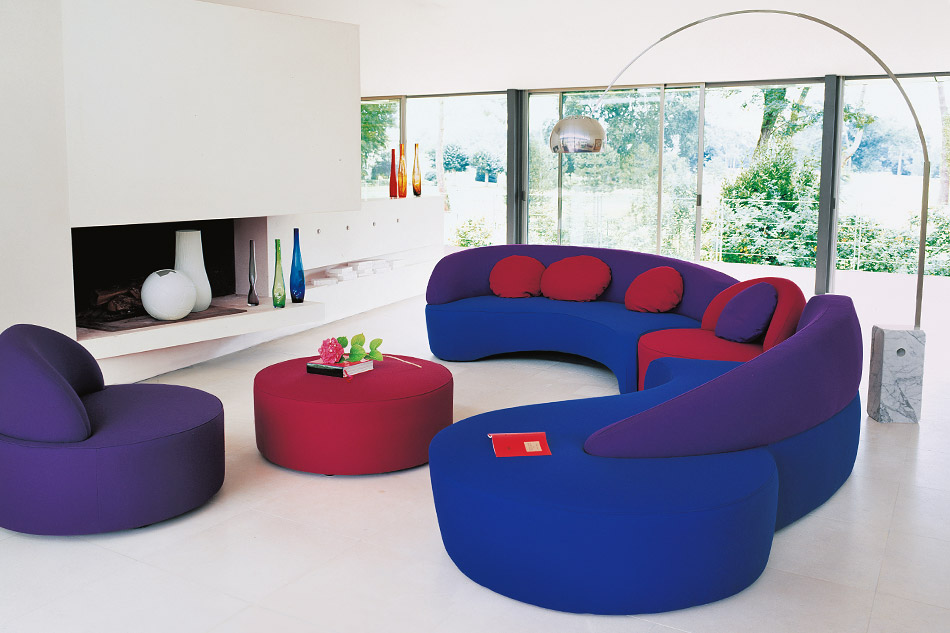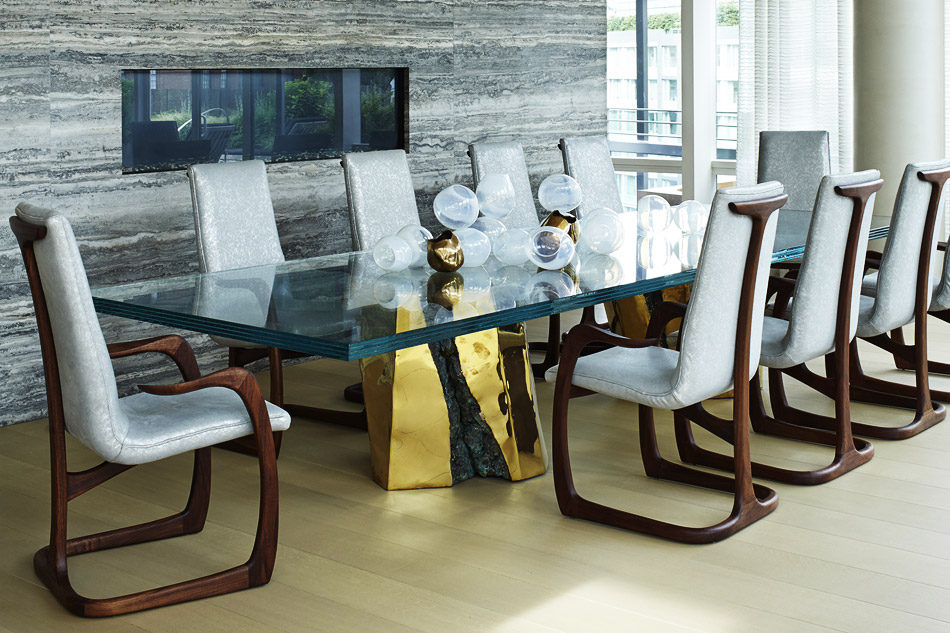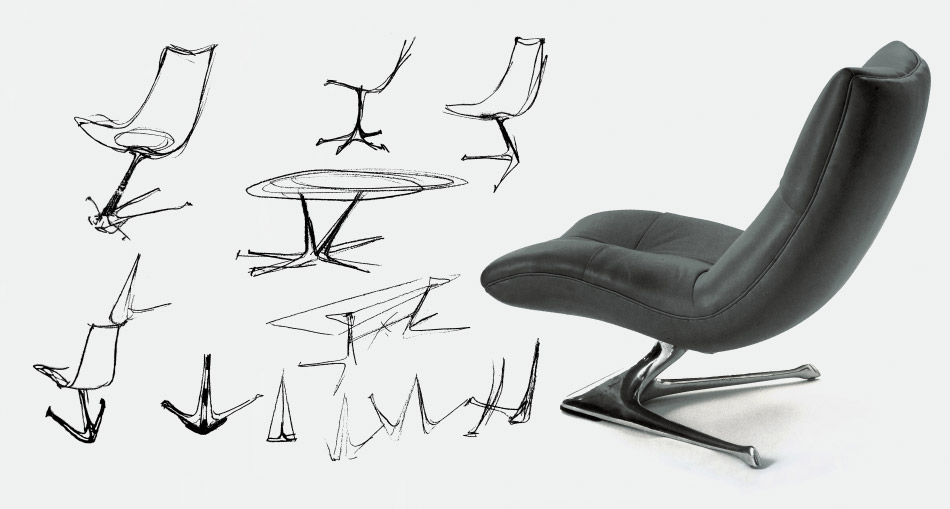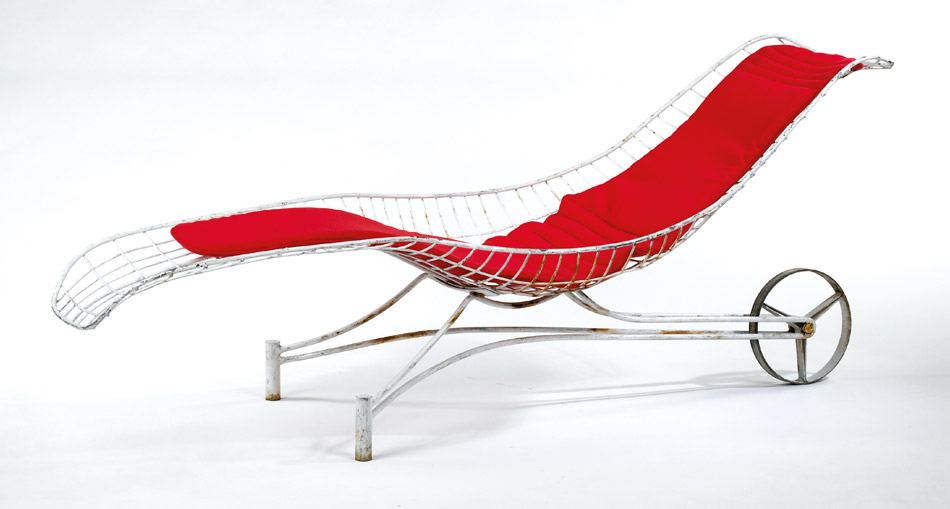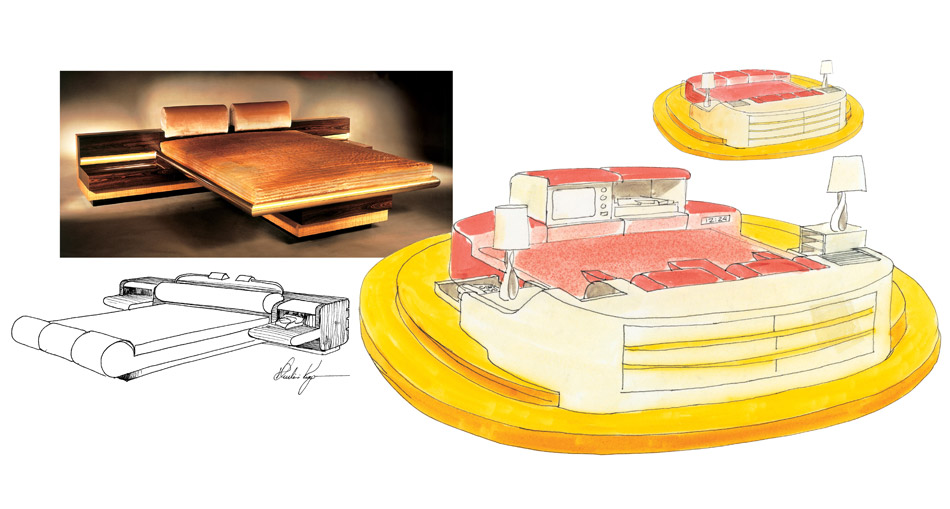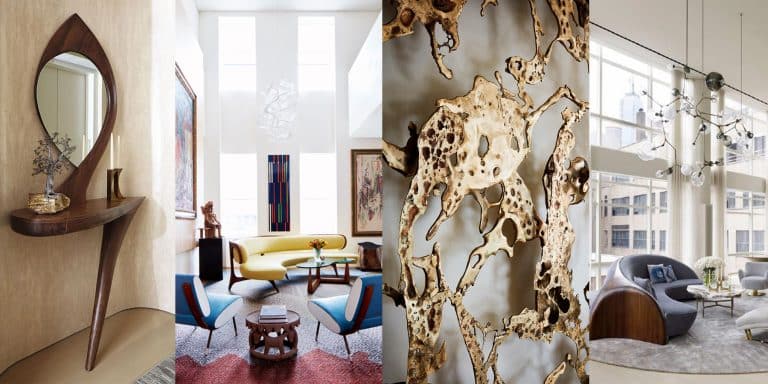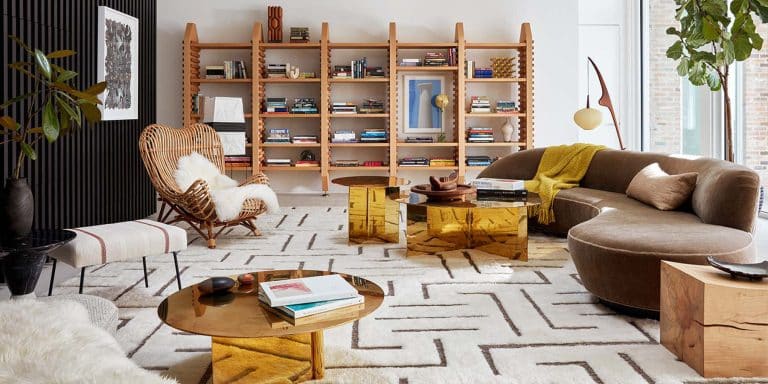
October 19, 2015A 28-year-old Vladimir Kagan poses in his Two Positions rocking chair (photo courtesy of the archive of Vladimir Kagan Design Group). Top: Kagan collaborated with interior designer Amy Lau on the custom furnishings for this splendid Manhattan living room (photo by Bjorn Wallander, courtesy of Amy Lau Design).
At 88, Vladimir Kagan could be resting on his laurels. His biomorphic designs — like the Serpentine sofa and Tri-symmetric glass table, with which he first made his name in the 1950s — are now sought-after signatures of mid-century modernism at its most glamorous and urbane. But for this dynamic legend, designing comes as naturally as breathing, so he’s still at it, with two new collections in the works, along with a host of private commissions. (More on these later.) And he’s accomplishing all this while flitting between three homes — a sprawling prewar on New York’s upper Park Avenue, a colonial in Nantucket and a pied-à-terre in Palm Beach — to spend time with family and friends, and jetting off to Europe to do the same. Talk about a design for living!
As famous as Vladimir Kagan is, few know that his genius transcends mere furniture design. From the start, what distinguished the German-born émigré from his American peers was that he was also a brilliant design impresario and a debonair tastemaker, as at home at El Morocco as in a woodworking shop. In 1947, when just 20, he dropped out of architecture school at Columbia University to help his father, Illi, a master cabinetmaker, with his business. As luck would have it, the pair soon scored a commission to provide the furnishings for the Delegates Cocktail Lounge at the United Nations’ first headquarters, which was located outside New York City, in Nassau County. Soon after, they opened a trailblazing furniture store on the Upper East Side modeled on the tony pair of shops the family had owned in Germany before the war.

When Kagan moved his business into a new 59th Street showroom in 1970, he outfitted the reception area with a Plexiglas desk that became a prototype for his Ribbon desk. A swivel office chair allowed the receptionist to move seamlessly between it and the typewriter station. Desk and chair were cleverly mounted on a platform cantilevered above the floor. Courtesy of the archives of Vladimir Kagan Design Group
Now, however, it was the young Kagan’s strikingly sinuous designs that were on display. Influenced as much by the Bauhaus as they were by antique styles and natural forms, these furnishings were highly original not just in shape but in materials and construction as well. And, rather unusual for the time, they were designed for comfort. “Vessels for the body,” he called them.
The store also featured the works of an assortment of artists and artisans, some of whom Kagan often collaborated with. The Greenwich Village silversmith Francisco Rebajes, for instance, created Cubist designs in hammered copper and silver to adorn the fronts of Kagan’s cabinets and bars. A little-known ceramicist at the shop, although not a collaborator, wanted to experiment with sculptural assemblage, so Kagan let her take scraps from the factory to work with. Her name was Louise Nevelson, and her early efforts were later sold at the store.
This then-novel mix of art, craft and design attracted a stylish clientele, including such celebrities as Gary Cooper and Marilyn Monroe and Arthur Miller. (Monroe and Miller’s order, alas, was cancelled when the couple decided to divorce.)
In the decades that followed, Kagan’s restless invention propelled him to experiment with ever-new materials, forms and technologies. (He was especially partial to revolving sofas.) His business hummed along until the 1980s, when a colder version of modernism took hold, along with a recession. Then in his 60s, Kagan was forced to close his showroom and factory and work in semiretirement as a design consultant. But within a decade, the growing craze for mid-century modernism had led to his “rediscovery” by a new generation of design mavens, including Gucci’s then-creative director Tom Ford. When, in 1997, the designer Bill Sofield commissioned 360 of his 1969 Omnibus “environments” for Ford’s new Gucci boutiques, Kagan was unexpectedly back in business.
Now, nearly 20 years later, in celebration of the newly updated edition of his 2004 monograph from Pointed Leaf Press, 1stdibs has convinced the former wunderkind and current eminence gris, to sit down for a moment and catch his breath while catching us up on his latest endeavors. He was ever so willing to oblige, admitting, “I very much enjoy all this floating about in the limelight. It’s wonderful because I don’t really care about anything any more, except having fun.”

Kagan’s early interest in adventurous creative collaborations extended to his choice of wife, a very tall young Englishwoman named Erica Wilson, who became a celebrated authority on and entrepreneur of needlework. (The Kagan-Wilson collaboration produced three children and this rocking chair, and the marriage lasted 54 years, until Wilson’s death in 2011.)
Are visitors surprised to find that you don’t live in the kind of minimalist apartment in which your work is typically seen?
[Much laughter.] I’m a designer, you should do as I say, not as I do! Though designers have taken to the minimalist mantra, which I admire, I’m a maximalist! Erica [Wilson, Kagan’s late wife, a celebrated authority on and entrepreneur of embroidery] and I were collectors of stuff. We never went anywhere without buying an extra suitcase to bring home more treasures, and we never de-acquisitioned. I like to think of this apartment as our English home, because we loved to mix things. In our house in Nantucket, there are only two pieces of mine, and in Palm Beach, all the furniture is thrift shop.
Nevertheless, haven’t you been working with a lot of designers on custom pieces for minimalist interiors?
Yes, it’s true. I love doing private commissions, even though my factory hates them. It’s debilitating for the flow of production. But it’s essential for me. It challenges me and keeps me involved in new trends in the design world.
Who are some of the designers you most enjoy working with on these commissions?
Amy Lau is certainly one, also Julie Hillman and Martyn Lawrence Bullard, who did Tommy Hilfiger’s house.

The dynamic Kagan with his frequent collaborator, interior designer Amy Lau, on a sofa specially designed for a Lau client.

The library of Kagan’s apartment features a tortoise-shell-patterned leather chair that was exhibited in 2004 at the Museum of Fine Art, Boston, and a glass-mosaic table that was an early Kagan work. The standing nude silhouette, as well as the small sculptures on the library steps, another Kagan design, are by his father, Illi. Courtesy of the archives of Vladimir Kagan Design Group
Speaking of new trends, are there any young furniture designers whom you admire?
Yes, it’s hard for me to remember names….I’m visual. But I do like the work of Sebastian Errazuriz. I very much enjoyed that exhibition of his [“Tough Love” at the Storefront for Art and Architecture] last year. Difficult stuff but good. And Aaron Scott, a Brooklyn designer, whom I first saw at the Architectural Digest show.
What about architects?
Zaha Hadid is a good friend. She wrote the preface to the new edition of my monograph, and I just blogged about her. I called her “my hero.” I say she out-curved Frank Gehry!
Tell me a bit about your blog
I’ve discovered I love writing! I never used to write. I used to be a long-distance runner and skier, but once I had to stop, I had all this time, so I took up this blog. Now I love it.

The original Serpentine sofa, first featured on the cover of a 1950 Kagan-Dreyfuss catalog, in a living room in Forest Hills, New York. The barrel chairs, coffee table and curtains are also from Kagan-Dreyfuss (Hugo Dreyfuss was Kagan’s business partner throughout the 1950s).

Over the past decade or so, Kagan has ventured into the realm of design art, producing limited-edition pieces in fiberglass and bronze for Ralph Pucci. He will soon introduce another collection through Carpenters Workshop. Photo by Antoine Bootz
What else are you up to right now?
I’m getting ready to go to London to see Wendell’s [Wendell Castle’s] new show at Carpenters Workshop and talk to Loïc [Le Gaillard] and Julien [Lombrail] about the collection I’m making for them. I’m very excited about it because there will be six to eight pieces! And I’ve been liberated from “form follows function” because I’m not being restricted by price or utility. I’m also creating more art furniture for Ralph Pucci, cast in bronze, which will debut in March in the Miami showroom.
Back to your classic work — the Omnibus sofa you have here in your living room was quite revolutionary when it was designed. How did it come about?
I conceived the modular, multilevel piece to run diagonally across a room to change the focus and liberate the walls to provide a lot more space for paintings. It also enables people to encounter each other in new ways, not like birds on a wire.

Kagan’s landmark Omnibus sofa in the living room of his commodious Park Avenue apartment, which he shares with his daughter and son-in-law and various pets. A Frank Stella painting adorns the back wall along with works of folk and tribal art that he and his late wife collected on their travels. Photo courtesy of New York Social Diary

Kagan modeled his aviary on a Victorian gazebo. At one time, it was a true menagerie, holding 30 birds. Photo courtesy of New York Social Diary
Speaking of birds, you also have an enormous aviary in this room but only two birds.
When we moved in here around 1970, I thought it would be fun to have an aviary, so I made this piece modeled on a Victorian garden structure. For a while we had thirty birds. But it was a mess to clean. And the only one willing to do it was Erica, of course. After awhile she said enough is enough, and we gave the birds away. Then I decided to get one bird, Conrad, and I felt it was unfair for him to be alone, so we got him a mate. He mounts her all the time, so I’m hoping we’ll have babies in the spring. You know, I love birds. As a child, they fascinated me because I wanted to fly. But that didn’t work out. Now I want to return [in his next life] as a seagull. You know why? Because they are a protected species, they can walk on land, swim and fly! And they get by fine eating garbage!

Purchase This Book
Or support your local bookstore
